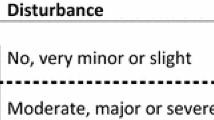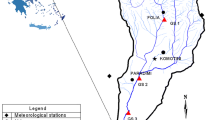Abstract
The Water Framework Directive (WFD) requires EU Member States to classify the ecological status of surface waters by using multiple biological quality elements (BQEs). According to the WFD Classification Guidance, a ‘one-out-all-out’ (OOAO) rule should be applied when integrating multiple BQEs into an overall biological status of a waterbody, i.e. classification is determined by the lowest status BQE. Using both simulated and monitoring datasets, we analyzed the effects of different combination rules in classification outcome and classification reliability. The OOAO represented the strictest combination rule in terms of increased probabilities of waterbodies being in moderate or worse status in comparison to other rules. The OOAO approach gave acceptable results when different BQEs were complementary, showing the effects of different pressures, and when level of uncertainty in the metrics used in the assessment was not high. Increasing the number of BQEs used in the assessment affected the classification outcome when using the OOAO approach; this was especially problematic if all BQEs address the same pressure. Our study showed that grouping of metrics and metrics uncertainty has a large influence on classification outcomes and that this should be carefully considered to ensure that final classification adequately reflects ecological status.








Similar content being viewed by others
References
Alahuhta, J., K.-M. Vuori, S. Hellsten, M. Järvinen, M. Olin, M. Rask & A. Palomäki, 2009. Defining the ecological status of small forest lakes using multiple biological quality elements and paleolimnological analysis. Fundamental and Applied Limnology 175(3): 203–216.
ANZECC, 2000. Australian and New Zealand Guidelines for Fresh and Marine Water Quality, Vol 1, Paper 4. Agricultural and Resources Management Council of Australia and New Zealand, Canberra.
Birk, S., J. Strackbein & D. Hering, 2010. WISER methods database. http://www.wiser.eu/results/method-database/. Accessed March 2011.
Borja, A. & J. G. Rodriguez, 2010. Problems associated with the ‘one-out, all-out’ principle, when using multiple ecosystems components in assessing the ecological status of marine waters. Marine Pollution Bulletin 60: 1143–1146.
Borja, A., J. Bald, J. Franco, J. Larreta, I. Muxika, M. Revilla, J. G. Rodriguez, O. Solaun, A. Uriarte & V. Valencia, 2009. Using multiple ecosystem components in assessing ecological status in Spanish (Basque Country) Atlantic marine waters. Marine Pollution Bulletin 59: 54–64.
Caroni, R. & W. van de Bund, 2010. Review of approaches for combining BQEs in WFD assessment. Wiser Deliverable 6.2-1. http://www.wiser.eu. Accessed Nov 2010.
Clarke, R., 2011 WISERBUGS (WISER Bioassessment Uncertainty Guidance Software). http://www.wiser.eu. Accessed June 2011.
Clarke, R. T., 2012. Estimating confidence of European WFD ecological status class and WISER Bioassessment Uncertainty Guidance Software (WISERBUGS). Hydrobiologia. doi:10.1007/s10750-012-1245-3.
Ellis, J. E., 2007. Combining Multiple Quality Elements and Defining Spatial Results for WFD Classification. Environmental Agency, Bristol: 1–40.
European Commission, 2000. Directive of the European Parliament and of the Council 2000/60/EC Establishing a Framework for Community Action in the Field of Water Policy. European Commission, PE-CONS 3639/1/100 Rev 1. Luxembourg.
Hering, D., R. K. Johnson, S. Kramm, S. Shmutz, K. Szoszkiewicz & P. F. M. Verdonschot, 2006. Assessment of European streams with diatoms, macrophytes, macroinvertebrates and fish: a comparative metric-based analysis of organism response to stress. Freshwater Biology 51: 1757–1785.
Hering, D., A. Borja, J. Cartensen, L. Carvalho, M. Elliott, C. Feld, A.-S. Heiskanen, R. Johnson, J. Moe, D. Pont, A. L. Solheim & W. van de Bund, 2010. The European Water Framework Directive at the age of 10: a critical review of the achievements with recommendations for the future. Science of the Total Environment 408: 4007–4019.
Johnson, R. K., D. Hering, M. T. Furse & R. T. Clarke, 2006. Detection of ecological change using multiple organism groups: metrics and uncertainty. Hydrobiologia 566: 115–137.
Lambert, D., A. Cattaneo & R. Carignan, 2008. Periphyton as an early indicator of perturbation in recreational lakes. Canadian Journal of Fisheries and Aquatic Sciences 65: 258–265.
Moss, B., 2008. The Water Framework Directive: total environment or political compromise? Science Total Environment 400(1–3): 32–41.
Moss, B., D. Stephen, C. Alvarez, E. Becares, W. van de Bund, S. E. Collings, E. Van Donk, E. De Eyto, T. Feldmann, C. Fernandez-Alaez, M. Fernandez-Alaez, R. J. M. Franken, F. Garcıa-Criado, E. M. Gross, M. Gyllström, L. A. Hansson, K. Irvine, A. Jarvalt, J. P. Jensen, E. Jeppesen, T. Kairesalo, R. Kornijow, T. Krause, H. Künnap, A. Laas, E. Lill, B. Lorens, H. Luup, M. R. Miracle, P. Nõges, T. Nõges, M. Nykänen, I. Ott, W. Peczula, E. T. H. M. Peeters, G. Phillips, S. Romo, V. Russell, J. Salujoõe, M. Scheffer, K. Siewertsen, H. Smal, C. Tesch, H. Timm, L. Tuvikene, I. Tõnno, T. Virro, E. Vicente & D. Wilson, 2003. The determination of ecological status in shallow lakes – a tested system (ECOFRAME) for implementation of the European Water Framework Directive. Aquatic Conservation: Marine Freshwater Ecosystems 13: 507–549.
Nõges, P. & T. Nõges, 2006. Indicators and criteria to assess ecological status of the large shallow temperate polymictic lakes Peipsi (Estonia/Russia) and Võrtsjarv (Estonia). Boreal Environmental Research 11: 67–80.
Pike, N. 2010. Using false discovery rates for multiple comparisons in ecology and evolution. Methods in Ecology and Evolution. doi:10.1111/j.2041-210X.2010.00061.x.
Rask, M., K. M. Vuori, H. Hämäläinen, M. Järvinen, S. Hellsten, H. Mykrä, L. Arvola, J. Ruuhijärvi, J. Jyväsjärvi, I. Kolari, M. Olin, E. Salonen & P. Valkeajärvi, 2011. Ecological classification of large lakes in Finland: comparison of classification approaches using multiple quality elements. Hydrobiologia 660(1): 37–47.
Sandin, L., 2005. Testing the EC Water Framework Directive “one-out, all-out” rule – simulating different levels of assessment errors along a pollution gradient in Swedish streams. Verhandlungen des Internationalen Verein Limnologie 29: 334–336.
SEPA, 2000. Environmental quality criteria. Lakes and watercourses. Swedish Environmental Protection Agency, Report 5050.
Søndergaard, M., E. Jeppesen, J. P. Jenser & S. L. Amsink, 2005. Water Framework Directive: ecological classification of Danish lakes. Journal of Applied Ecology 42: 616–629.
U.S. EPA, 2003. Strategy for water quality standards and criteria: setting priorities to strengthen the foundation for protecting and restoring the nation’s waters. Office of Water (4305T), EPA-823-R-03-010: 1–48.
Working Group 2A, 2003. Guidance Document No 13 Overall Approach to the Classification of Ecological Status and Ecological Potential. Office for Official Publications of the European Communities, Luxembourg: 47 pp.
Working Group ECOSTAT, 2009. Guidance on the Intercalibration Process 5th Draft. European Commission: 62 pp.
Acknowledgments
This paper is a result of the project WISER (Water bodies in Europe: Integrative Systems to assess Ecological status and Recovery) funded by the European Union under the 7th Framework Programme, Theme 6 (Environment including Climate Change) (contract No. 226273), www.wiser.eu. We wish to thank two anonymous reviewers for critical comments that greatly contributed to improve the paper.
Author information
Authors and Affiliations
Corresponding author
Additional information
Guest editors: C. K. Feld, A. Borja, L. Carvalho & D. Hering / Water bodies in Europe: integrative systems to assess ecological status and recovery
Rights and permissions
About this article
Cite this article
Caroni, R., van de Bund, W., Clarke, R.T. et al. Combination of multiple biological quality elements into waterbody assessment of surface waters. Hydrobiologia 704, 437–451 (2013). https://doi.org/10.1007/s10750-012-1274-y
Received:
Accepted:
Published:
Issue Date:
DOI: https://doi.org/10.1007/s10750-012-1274-y




